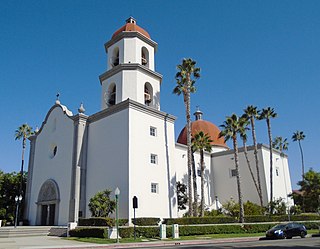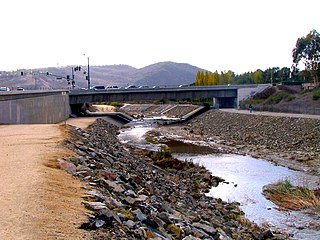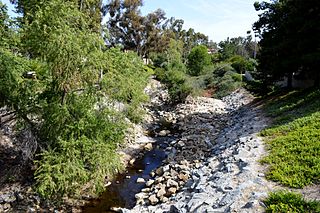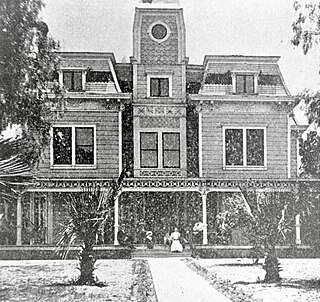
San Juan Capistrano is a city in southern Orange County, California, United States. The population was 35,253 at the 2020 Census.
Putuidem, alternative spelling Putiidhem or Putuidhem, was a large native village of the Acjachemen people, also known as Juaneño since their relocation to Mission San Juan Capistrano. Putuidem was a mother village, a community that spawned other villages of the tribe.

Doheny State Beach is known as the first state beach in the California state park system. Located on the Pacific Ocean in the city of Dana Point, the beach is adjacent to several surf spots and scenic beaches including Salt Creek Beach, Baby Beach, and Capistrano Beach. Along with its neighbors, Doheny beach is a popular surf spot located at the mouth of San Juan Creek, which flows from the Santa Ana Mountains southwest to the beach, where it forms a fresh-water lagoon.
JSerra Catholic High School is a private coeducational Catholic high school located in San Juan Capistrano, California. Named after Saint Junípero Serra, the school was founded by parents in 2003 and is an independent school sanctioned by the Diocese of Orange.

The Acjachemen are an Indigenous people of California. Published maps often identify their ancestral lands as extending from the beach to the mountains, south from what is now known as Aliso Creek in Orange County to the Las Pulgas Canyon in the northwestern part of San Diego County. However, sources also show that Acjachemen people shared sites with other Indigenous nations as far north as Puvunga in contemporary Long Beach.

San Juan Creek, also called the San Juan River, is a 29-mile (47 km) long stream in Orange and Riverside Counties, draining a watershed of 133.9 square miles (347 km2). Its mainstem begins in the southern Santa Ana Mountains in the Cleveland National Forest. It winds west and south through San Juan Canyon, and is joined by Arroyo Trabuco as it passes through San Juan Capistrano. It flows into the Pacific Ocean at Doheny State Beach. State Route 74, the Ortega Highway, crosses the Santa Ana Mountains via San Juan Canyon.

Aliso Creek is a 19.8-mile (31.9 km)-long, mostly urban stream in south Orange County, California. Originating in the Cleveland National Forest in the Santa Ana Mountains, it flows generally southwest and empties into the Pacific Ocean at Laguna Beach. The creek's watershed drains 34.9 square miles (90 km2), and it is joined by seven main tributaries. As of 2018, the watershed had a population of 144,000 divided among seven incorporated cities.

Oso Creek is an approximately 13.5-mile (21.7 km) tributary of Arroyo Trabuco in southern Orange County in the U.S. state of California. Draining about 20 square miles (52 km2) in a region north of the San Joaquin Hills and south of the Santa Ana Mountains, the creek is Trabuco Creek's largest tributary, and is part of the San Juan Creek drainage basin. Beginning in the foothills of the Santa Ana Mountains near the city of Mission Viejo, the creek is dammed twice to form Upper Oso Reservoir and Lake Mission Viejo. The creek is channelized and polluted along much of its length.

Arroyo Trabuco is a 22-mile (35 km)-long stream in coastal southern California in the United States. Rising in a rugged canyon in the Santa Ana Mountains of Orange County, the creek flows west and southwest before emptying into San Juan Creek in the city of San Juan Capistrano. Arroyo Trabuco's watershed drains 54 square miles (140 km2) of hilly, semi-arid land and lies mostly in Orange County, with a small portion extending northward into Riverside County. The lower section of the creek flows through three incorporated cities and is moderately polluted by urban and agricultural runoff.

Salt Creek is a small coastal stream in southern Orange County, California in the United States. About 4 miles (6.4 km) long, the creek drains 6.1 square miles (16 km2) in parts of the cities of Laguna Niguel and Dana Point. The creek begins in Laguna Niguel and flows west and south through a narrow canyon, partly in the Salt Corridor Regional Park. It empties into the Pacific Ocean at Salt Creek County Beach in Dana Point.

Santiago Creek is a major watercourse in Orange County in the U.S. state of California. About 34 miles (55 km) long, it drains most of the northern Santa Ana Mountains and is a tributary to the Santa Ana River. It is one of the longest watercourses entirely within the county. The creek shares its name with Santiago Peak, at 5,687 ft (1,733 m) the highest point in Orange County, on whose slopes its headwaters rise.

Sulphur Creek is an approximately 4.5-mile (7.2 km) tributary of Aliso Creek in Orange County, California. The creek drains about 6 square miles (16 km2) in the suburban cities of Laguna Niguel and Laguna Hills. Although most of its watershed has been utilized for master planned residential development, the creek retains a natural channel with riparian and wetland habitat in parts of Laguna Niguel Regional Park and Aliso and Wood Canyons Regional Park. Urban runoff has changed the once seasonal creek into a perennial stream.

Bell Canyon is a major drainage of the Santa Ana Mountains in Orange County, California in the United States. Bell Creek flows about 14.4 miles (23.2 km) in a southerly direction to its confluence with San Juan Creek. The Bell Canyon drainage is located to the east and parallel to Cañada Gobernadora, and to the south of Trabuco Creek. After Trabuco Creek, it is the second largest tributary of San Juan Creek in terms of length and its watershed area of 26 square miles (67 km2).

Gilman Hot Springs, also known as San Jacinto Hot Springs or the Relief Springs, is a hot spring system in the Inland Empire area of Southern California. Located near Potrero Creek, the San Jacinto River, and California State Route 79, the springs system consists of "about half a dozen" springs named for the Mexican land grant Rancho San Jacinto Viejo.

Seminole Hot Springs is an unincorporated community in Los Angeles County, California, United States. Seminole Hot Springs is located in the Santa Monica Mountains near Cornell, 3.6 miles (5.8 km) south-southeast of Agoura Hills at an elevation of 932 feet (284 m).

Alume was a large Acjachemen village located at the foot of Santiago Peak, upstream from the village of Putiidhem ,within what is now O'Neill Regional Park near the Trabuco Adobe, which was built in 1810 as an outpost of Mission San Juan Capistrano. The village was also recorded as Alaugna and as El Trabuco in San Juan Capistrano mission records, and is also referred to as Alauna, Aluna, and Alona. The village was also acknowledged by the Payómkawichum.

Acjacheme was an Acjachemen village that was closely situated to the mother village of Putuidem in what is now San Juan Capistrano, California. The Spanish missionaries constructed Mission San Juan Capistrano less than 60 yards from the village in 1776. Acjachemen is a pluralization of the word Acjacheme, and became the moniker for the people overall after the mission period.

Fairview Hot Springs was a resort hotel in Fairview, California, United States from about 1887 to about 1918. The source of the water that constituted the "hot springs" was actually a well that yielded a combination of heated artesian water and natural gas. The Fairview Hot Springs was known for its mudbaths, but the Fairview development was already languishing, when—due to either financial failure generally, or the 1918 San Jacinto earthquake specifically—the resort hotel closed its doors for good around 1918.

Soboba Hot Springs are a historic hot springs and resort in Riverside County, California, United States. The springs issued from the side of a steep ravine "with narrow, precipitous sides, and the rock exposed is largely a crushed gneiss...the thermal character of the springs is due to crushing and slipping of the rocks". The Soboba Hot Springs resort was adjacent to the reservation of the Soboba Band of Luiseño Indians. Soboba means hot water in the Luiseño language.

Ontario Hot Springs is a hot-water well in southern San Luis Obispo County, California, United States. The geothermally heated water from the well is the central feature of a resort called Avila Hot Springs near Avila Beach.





























